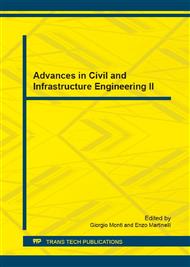p.3
p.10
p.17
p.25
p.31
p.38
p.46
p.53
p.60
Experimental Study on the Size Effect on Flexural Behavior of Larch Glulam Beams
Abstract:
At present, design values in codes and regulations are mainly based on test results of small size specimens, which are different from large-scale members used in practical engineering, therefore size adjustment coefficients are needed to be established. The four-point bending test method was adopted to investigate four groups of different sizes of Larch Glulam beams in their flexural behavior. Experiment data such as ultimate bearing capacity, deflection, strains and others are obtained, and the failure pattern and failure mechanism of bending members are analyzed. The research results indicate that the bending modulus of elasticity of Larch Glulam beam is not affected by the size. Bending strength of the Larch Glulam beam show a declining trend as the size of specimens increases, however, the ultimate bending moment increases. In addition, by means of a two-parameter Weibull model, a so-called size effect coefficient has been calculated by the slope method, thus providing a basis for the design and application of Larch Glulam beams.
Info:
Periodical:
Pages:
3-9
Citation:
Online since:
July 2016
Authors:
Keywords:
Price:
Сopyright:
© 2016 Trans Tech Publications Ltd. All Rights Reserved
Share:
Citation:


